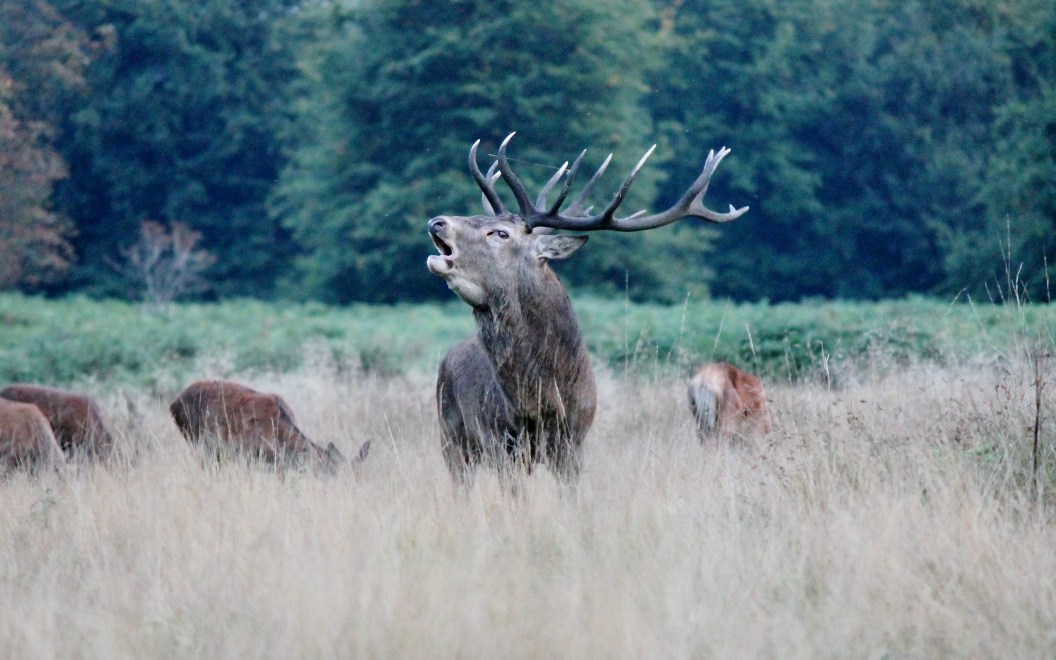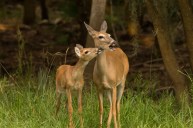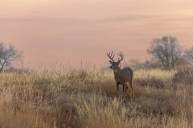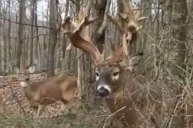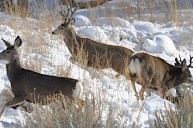Whitetail deer might seem like quiet creatures, but in fact they communicate vocally quite a bit. However, different deer noises may all sound the same or very similar to the untrained ear. The truth is, deer's different vocalizations have lots of different meanings—all of which you need to learn in order to become a better hunter. Here's what you need to know.
How Learning Deer Sounds Helps Your Hunt
Understanding the behavioral intricacies of whitetail deer is no easy feat. These language complexities make hunting deer both fun and challenging. Fortunately, humans have been studying all of these vocalizations for years for both hunting and conservation purposes, which has led to a better understanding of what each noise means. We now can now decipher micro variations in dialect, giving us a deeper sense of what deer are trying to say.
Without question, learning these different vocalizations and what they mean will make you a better hunter. Learning the sounds deer make can make you that much better at deer calling. But it also helps you to understand why deer act the way they do in certain situations. Knowing how to identify the four common sounds deer make, what each deer sound means, and what prompted the deer to make it, will help make you a better hunter in the long run.
Deer Sound #1: Grunts and Growls
A grunting sound is easily the most common vocalization hunters will hear in the deer woods. The grunt is a standard form of communication, but there are a few different variations of grunts that all have slightly different sounds.
If you spend enough time in a blind or a stand watching adult deer and hear these grunts and observe the behavior that follows, eventually you start to make sense of the context of the situation, and you start to understand the nuances between common sounds and the different sounds that deer make—and begin to emulate them. You can emulate all of these sounds with a grunt call, which is particularly effective when a buck is riled up. Effective calling and timing of those sounds will bring a buck right to you.
The most common deer grunt is a low and quick "urp" sound, which is what's called a contact grunt or social grunt. Both male deer and female deer use these grunts to announce their presence in an area and identify themselves to other deer, almost like saying, "Hello, I'm here." They sound a little different between the sexes, but both serve as a way of establishing a social hierarchy.
The Doe Grunt
A doe grunt is one of the common sounds deer make. A doe grunt is much higher sound than that of a buck. Female deer have smaller bodies, and just like in humans, this results in a shorter airway. Does use grunts in a slightly different way than bucks do. Does don't really grunt to show dominance, but more so to communicate with one another. Deer are highly social, and they try to gather together when they can, so a grunt is the deer's way of telling others it's around and ready to mingle, so to speak. The mothers also grunt to call the fawns if it's feeding time or if they're moving to a new location, almost like a mother raising her voice to her children.
I couldn't count the number of times I've watched does feeding right out in front of me, only to start sparring with the younger deer and chasing them off. The whole time, the more mature doe was making this grunt noise, which became deeper, raspier, and more aggressive as she asserted more dominance.
The Buck Grunt
A buck grunt is a different sound that is a little deeper and guttural than that of a doe, which produce more of a higher, nasally sound. Bucks make a loud grunting sound to show their dominance. While all deer make soft, long grunts to call to one another, the deep, short grunt of the buck is the male claiming does and territory.
When most of us think of buck sounds, our mind gravitates to buck grunts. We think of that echoing, saliva-inducing sound that only comes from a buck during the rut. However, there's again a wide range of variations, but all of them are unique to the peak of hunting season.
While bucks will use short grunts to stake out their territory and intimidate rivals, they sometimes use the same sound to establish dominance when chasing does, which many often call "trailing grunts." The sound is virtually unmistakable and enough to get any hunter's blood pumping, as it means only one thing: a buck is coming in hot on a doe's trail, so get ready for action. The sound itself is somewhat of an excited "urp-urp-urp-rup" along with the ruckus of crunching leaves and cracking branches.
The Tending Grunt
Another type of deer grunt is a tending grunt. A tending grunt is a deer call made by bucks when they are following a doe during rut and want to mate. The tending grunt is a deep guttural call made of long, drawn-out notes, softly, without aggression or loudness—a guttural "urrrrrrrrrp" sound, which often includes a mix of short grunt sounds, too, all of which signify ownership to a doe, as well as other interested bucks. Big bucks use this grunt to assert their dominance, frustration, and let everyone in the area know what they are after. They also use it to ask the doe to stop so they can breed.
The Buck Growl
Slightly less common is the "buck bawl," "growl," "rage grunt," "breeding bellow," or "buck roar," all of which are different names for the sound big bucks make when an estrous doe is near. Noticeably lower and a tad eerie, this guttural vocalization doesn't even sound like it's coming from a deer. The video above is a perfect example of just that. Rutting bucks make this sound when they're frustrated—which is exactly what it sounds like—because they're lonely or a doe hasn't allowed them to breed yet.
A number of grunt calls have hit the market in recent years to create a version of this sound, but it's a difficult one to pull off, and thus should be reserved for experienced callers. Without the perfect pitch and cadence, you'll run the risk of scaring away bucks instead of attracting them. However, if you're looking for a new challenge, or if you feel like you're grasping for a new approach after failing with some of your default calls, it's worth a try.
Deer Sound #2: Bleats
Doe bleats, much like grunts, have numerous variations, all dependent on a given situation. Like deer grunts, bleats happen in a variety of situations and each different sound has its own meaning.
A common doe bleat happens in social situations. The bleat is a higher-pitched vibrating sound, similar to that of a goat. They mostly do it when they are gathered together or with their fawns, and it signals contentment.
Bleat calls are interesting. Much like grunts, it seems bleats have many different meanings depending on the situation. First there are estrus doe bleats, which they make when they're in heat but there aren't any bucks around. The intensity of this sound comes down to how long the doe has gone without a suitor. Most of the can-style calls you can buy on the market are designed to resemble a more desperate mating call but does use bleats all year long for various purposes, one of which is to communicate with their fawns.
Additionally, fawn bleating can be a distress call. It's this reason we hear this sound used for coyote hunting, as the agonizing sound triggers nearby predators who might be looking for an easy meal.
Deer Sound #3: Snort-Wheeze
A common sound deer make is the deer snort, or snort wheeze. The snort-wheeze is an intimidation call and one that's just not a sound or deer call one hears very often. This one has a sound like the deer is trying to clear some stuffed-up sinuses. This is the call mature bucks like to use in the pre-rut and rut when they want to intimidate a rival away from their does. Hunters could potentially hear this one when there are two bucks in the same area during that prime time.
This deer snort call sounds exactly like it is described. It's a short, loud sniff or snorting sound followed by a long wheeze. It's a different sound than the common deer grunts and bleats hunters usually hear in the woods.
It's also worth noting that bucks sometimes use the two parts of the snort wheeze on their own. For a large, dominant buck, they might only need to give a single snort to send a younger rival packing. Whatever sound they use, if you see and hear a buck making these sounds, do a scan of your surroundings. It is likely there is another buck in the area that you haven't
Deer Sound #3: Blowing
One common sound that deer make, especially does, is blowing. Blowing is an alarm sound often accompanied by stomping. If you're new to hunting, this is the most likely deer vocalization you will hear first. Veteran hunters know what I'm talking about. There are several stages to a doe sensing danger, and the annoying thing is, every one of them escalates as they warn other deer in the area that something just isn't right.
Big, mature does especially are the ones you'll hear blowing the most. These does are the wise old matriarchs of their group, and they're always on the lookout for danger. Their instinct is to protect the baby deer in the group. Usually, if a doe spots you, it'll start out with a stare-down, then the doe will start stomping her feet.
The foot stomping says to other deer, "Hey, something isn't right here, be on alert!" Once the doe is certain there's danger, she'll loudly start blowing. It's a very shrill sound, almost like a whistle. If it makes you jump when you hear it, that's what the doe intended.
Once a doe starts making this sound, it's gameover for your hunt. Does who have been spooked will often run off while continuing to make the sound as they vanish out of sight. This is the one call you don't want to hear or emulate!
Deer Sound #4: Sniffs
Whitetail deer have an amazing sense of smell. If a deer begins to sense something is off, they may start sniffing the air, sometimes quite aggressively. Not only are they trying to get a better smell, but they're also alerting the rest of the herd. The sniff doesn't sound much different than a human sniff, only stronger and deeper. Imagine air being sucked in through a deer's large nose.
